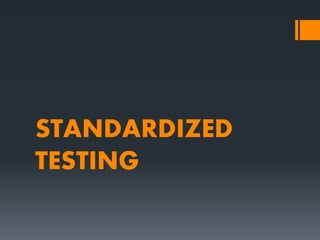
Standardized testing.pptx 2
- 2. Standardized Test It presupposes certain standard objectives, or criteria, that are held constant across one form of the test to another. It measurers the children’s mastery of the standards or competencies that have ben prescribed for specific grade levels.
- 3. Advantages of Standardized Test It is a ready-made previously validated product that frees the teacher from having to spend hours creating a test. Administration to large groups can be accomplished within reasonable time limits. In the case of multiple-choice formats, scoring procedures are streamlined for either scannable computerized scoring or hand-scoring with a hole- punched grid for fast turnaround time.
- 4. Disadvantages of Standardized Test Inappropriate use of such tests. Example: using an overall proficiency test as an achievement test simply because of the convenience of the standardization.
- 5. Developing a Standardized Test Legend: TOEFL – The Test Of English as a Foreign Language ESLPT – The English as a Second Language Placement Test GET – The Graduate Essay Test
- 6. 1. Determine the purpose and objectives of the Test It is important for the test’s purpose and objectives to be stated specifically. Example: TOEFL – its purpose is to evaluate English proficiency of people whose native language is not English. ESLPT – designed to place already admitted students in an appropriate course in academic writing, with the secondary goal of placing students into courses in oral production and grammar-editing.
- 7. The content of test must be designed to accomplish those particular ends. Each test has a specific gate-keeping function to perform; therefore the criteria before entering those gates must be specified accurately.
- 8. 2. Design Test Specifications This is the step of laying the foundation stones of the test. Example: TOEFL – Specifications: 1. Listening Section 2. Structure Section 3. Reading Section 4. Writing Section Each specs are not just stated that way, it should include what does it measures, what does it covers, and what material it uses.
- 9. 3. Design, select and arrange test tasks/items Once specifications for a standardized test have been stipulated, the task of designing, selecting and arranging test tasks/items begins. The specs act much like a blueprint in determining the number and types of items to be created.
- 10. 4. Make appropriate evaluations of different kinds of items. Item facility (IF) – % of people who give the right answer Item Discrimination (IDis) – indicates the extent to which success on an item corresponds to success on the whole test. Item Difficulty (ID) - finding out the % of people who get the item right in the try-out group.
- 11. 4. Make appropriate evaluations of different kinds of items. Performing them may not be practical especially if the classroom-based test is a one-time test. But for a standardized multiple-choice test that is designed to be marketed commercially, or administered a number of times, and administered in different form, these indices are a must.
- 12. 4. Make appropriate evaluations of different kinds of items. There are different form of evaluation for other types of response formats. (ex. Production responses) Practicality - Clarity of directions Timing of the test Ease of administration Time required to score responses.
- 13. 4. Make appropriate evaluations of different kinds of items. Reliability – is the degree to which an assessment tool produces stable and consistent results. Facility – Unclear directions Complex language Obscure topics Fuzzy data Culturally biased information.
- 14. 5. Specify scoring procedures or formats A systematic assembly of test items in pre-selected arrangements and sequences, all of which are validated to conform to an expected level of difficulty, should yield a test that can then be scored accurately and reported back to test- takers and institutions efficiently.
- 15. 6. Perform on going construct validation studies No standardized instrument is expected to be used repeatedly without a rigorous program of on going construct validation. Any standardized test, once developed, must be accompanied by systematic corroboration of its effectiveness and by steps towards its improvement.
- 16. Standardized Language Proficiency Tests Standardized oral production tests 1. TSE – Test of Spoken English 2. OPI – Orals Proficiency Inventory 3. TWE – Test of Written English
- 17. Standardized Language Proficiency Tests Commercially produced standardized tests of English language proficiency: 1. TOEFL – The Test Of English as a Foreign Language 2. MELAB – Michigan English Language Assessment Battery 3. IELTS – International English Language Testing System 4. TOEIC – Test of English for Internatioonal Communication
- 18. End
